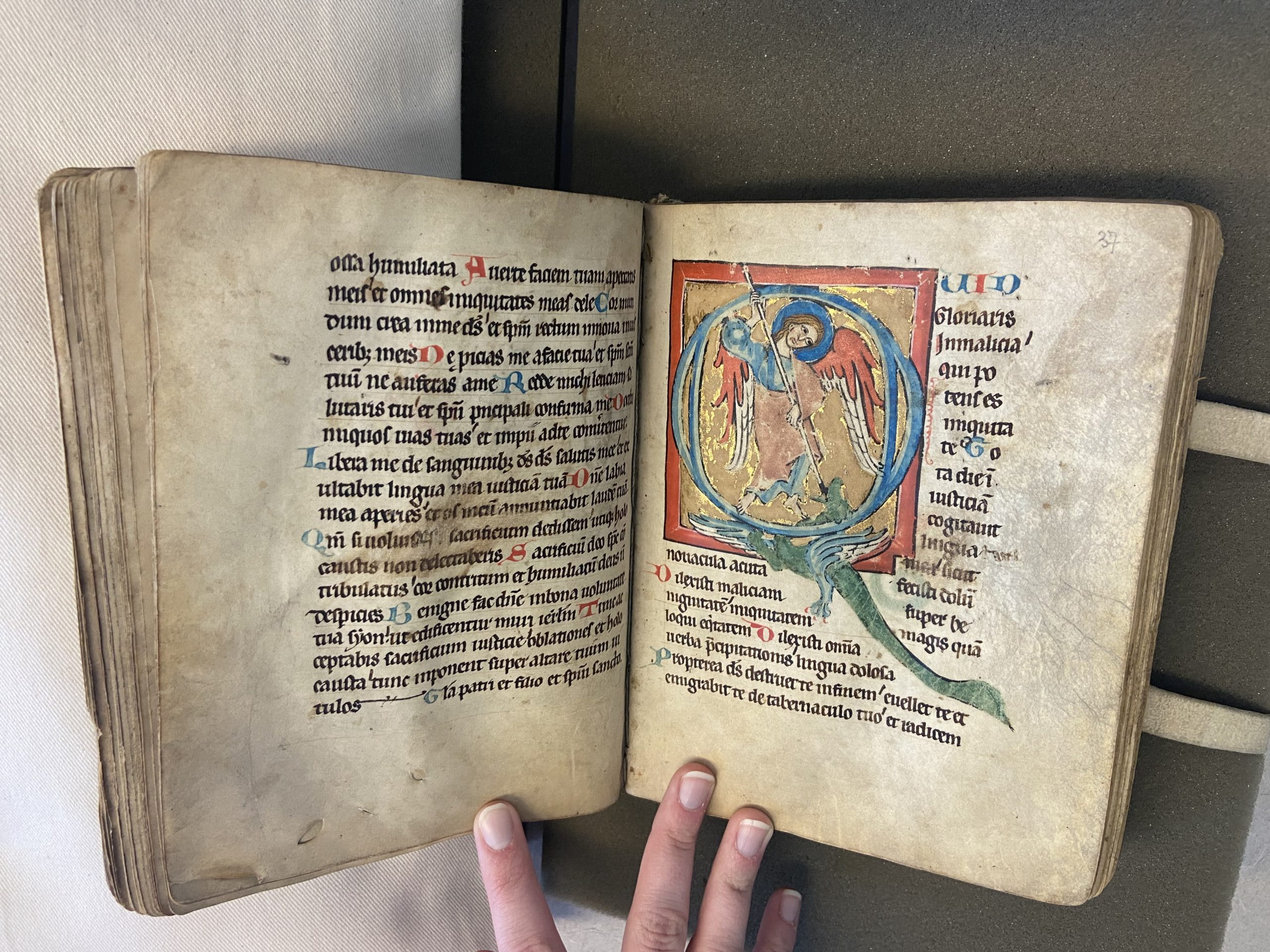The Constance Psalter from Southern Germany is a quirky manuscript to say the least. From dragons to defaced saints, the manuscript certainly does not disappoint. While the Les Enluminures description provides a comprehensive overview of the Psalter, this is my cliffnotes version. You’re welcome.
Composed of parchment and bound by an outer cover of leather-wrapped wood, the Psalter is supposed to have been completed sometime between 1240 and 1260. The binding itself is presumably original as evidenced by the parchment coming flush to the cover, but somewhat restored, which you can see in the metal components of the cover. These metal bosses exist to protect the integrity of the leather from any possible abrasion that may occur when the cover lies open on any surface. The clasps are punk-y, too, and exist to secure the manuscript on-the-go.

TM 789. Photo from Les Enluminures,
The Psalter gets a lot more interesting once you crack it open, though. It features 150 of the Vulgate Psalms. The Vulgate Bible was assembled in Latin in the fourth century by Saint Jerome and does not line up exactly with contemporary English Bibles. For context, Psalm 52 in the King James Version of the Bible is actually numbered as Psalm 51 in the Latin Vulgate.

Saint Michael and dragon, TM 789. Photo from Les Enluminures.
The Psalms, in any translation, are a collection of Old Testament poems. Most are written by King David, but some are of unknown authorship. The Psalms in this Psalter are also followed by additional Old Testament excerpts (including the Ferial Canticles, the Daily Canticles, and Creeds).
As far as the purpose behind the manuscript goes, the Constance Psalter was supposedly commissioned for laypeople, which are people that are not employed by the church (as monks or priests would be). Therefore, the Psalter existed as a way for religious people to connect with God in the domestic sphere. It is also possible that this Psalter was used to teach children how to read and/or write. This is evidenced by an alphabet and other elementary annotations that have been drawn in the margins of some of the folios.
The major divisions of text occur in front of several of the Psalms. They are marked by historiated and decorated initials, illuminated in red, blue, and green inks, and highlighted in goldleaf. Arguably, the most notable of these is the historiated initial “Q” on folio 37 recto, which features a haloed Saint Michael the Archangel slaying a bright green dragon (pictured below). This specific historiated initial precedes Psalm 52 (Vulgate 51), which was written by David. This Psalm, even in the Vulgate translation, discusses the conflict between David and King Saul (and theater party, Doeg the Edomite). The historiated initial relates, presumably, because it represents a similar, over-arching conflict between good and evil.
Lesser divisions of text are marked by decorated versal initials, which alternate between those penned in red ink and pen-flourished with blue ink and those penned in blue ink and pen-flourished with red ink. Each line or verse is separated by smaller versal initials, and these also alternate between red and blue ink.
Illuminations of Saint Francis and Saint Dominic are also depicted in the Psalter as historiated initials. These illuminations are composed with more gold leaf and are very intricate. Some of these are defaced, which is interesting. I am not qualified to hypothesize why the images of the saints are defaced, but I do have a classmate looking into possible explanations.

TM 789. Photo from Les Enluminures.
Overall, the Constance Psalter is a fun—and (I’m told) expensive—handful of history, and I’ve had such a good time getting acquainted with the book in class. And, I definitely recommend signing up for classes without reading the course description because that’s how Mr. Constance Psalter and I have become such good friends!
Header image: Open folio 36 verso and 37 recto featuring initial ‘Q’ historiated with
Saint Michael and dragon, TM 789. Photo taken in class.
Works Cited
Contributors to Wikimedia projects. “Canticle – Wikipedia.” Wikipedia, the Free Encyclopedia, Wikimedia Foundation, Inc., 19 Dec. 2003, https://en.wikipedia.org/wiki/Canticle.
—. “Francis of Assisi – Wikipedia.” Wikipedia, the Free Encyclopedia, Wikimedia Foundation, Inc., 13 Dec. 2001, https://en.wikipedia.org/wiki/Francis_of_Assisi.
—. “Jerome – Wikipedia.” Wikipedia, the Free Encyclopedia, Wikimedia Foundation, Inc., 28 Aug. 2001, https://en.wikipedia.org/wiki/Jerome.
—. “Saint Dominic – Wikipedia.” Wikipedia, the Free Encyclopedia, Wikimedia Foundation, Inc., 13 Dec. 2001, https://en.wikipedia.org/wiki/Saint_Dominic.
“Latin Vulgate Bible, Psalms Chapter 51.” Douay-Rheims Catholic Bible Online, Search Study Verses., https://www.drbo.org/lvb/chapter/21051.htm. Accessed 29 Nov. 2022.
Les Enluminures, TM 789, The Constance Psalter.
“Psalm 52 NIV – Psalm 52 – For the Director of Music. A – Bible Gateway.” Bible Gateway, https://www.biblegateway.com/passage/?search=Psalm%2052&version=NIV. Accessed 18 Nov. 2022.
“Vulgate.” Encyclopædia Britannica, Encyclopædia Britannica, https://www.britannica.com/topic/Vulgate. Accessed 18 Nov. 2022.
